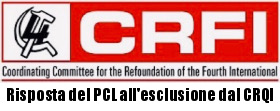Internazionale
The end of the West?
The cyclone of Trumpism and the vertiginous crisis of the transatlantic axis
11 Marzo 2025
Two great imperialist powers, the US and Russia, have opened negotiations for the partition of Ukraine. European imperialisms, dumped by Trump and ignored by Putin, are looking for a way to get back on the scene and participate in the banquet, but are suffering a heavy marginalization of their role. Zelensky is willing to give his country’s mineral resources to the US in exchange for military protection, only to be humiliated on mondovision by the US imperialism that he has always presented to the Ukrainian people as a “friend.” Putin, for his part, enthusiastically applauds Trump’s turnaround, while the daily bombardment of Ukraine and the annexation of regions conquered by the invasion continue.
These facts, which are absolutely clear in the eyes of the world — and to which we will return in the coming days — are only the emerging tip of a profound upheaval in world relations. A process in full swing, at an accelerated pace. A process that must be analyzed, using the Marxist method, by successive approximations.
THE TURN OF TRUMP II
The second Trump administration is not the continuity of the first (2016-2020). The Trump who entered the White House in 2016 — as an outsider surprised by his own success — faced resistance from an unconquered Republican Party, the hostility of the Wall Street and Silicon Valley big bourgeoisie, and the big mass mobilizations of Black Lives Matter and women. The dramatic Covid experience and the great capitalist recession that accompanied it gave the coup de grâce to the first Trump government, immortalized by the famous final assault on Capitol Hill and the subsequent court cases.
Today everything is different. Donald Trump has returned to Washington as victor. He has a consolidated electoral consensus. Of a Republican Party now molded in his own image. Of a majority, albeit a slim one, in both houses of Congress. But above all, of the support of American big business, starting with the giant technology monopolies. Monopolies directly involved, in Musk’s case, in the federal government, with extraordinary powers of intervention, without a legal basis, over the entire body of public administration.
Trump is in fact building around himself his own system of power, at once internal and parallel to the traditional institutions of the American bourgeois state.
This is the potential for regime change, not just government change. A change that immediately raises the level of attack on the rights of workers, women, Latin American migrants, and all oppressed sectors of society. The international reactionary advance, also in Europe, offers Trump a more favorable wind, while in turn receiving new impetus from Trumpism. Meanwhile, the social and democratic opposition in the US is struggling to recover from the huge disappointment of the Biden experience, and is still a long way from the mobilization levels of 2016-2018.
THE BIG TURN IN US FOREIGN POLICY
The discontinuity of the second Trump term also and above all manifests itself in foreign policy. Shorn of pragmatic, buffoonish, or pure improvisational elements, certainly present in the Trump persona, the US president’s international line follows a new strategic compass. A new response to the deep crisis of US imperialism in the world. Not an isolationist response (objectively impracticable for a planetary power like the US), but a different rationalization of its global direction.
First, the Trump administration aims to drastically reduce the volume of US foreign policy spending, as the specific weight of the US economy in the world shrinks. US imperialism has long been living above its material means. The US share of world manufacturing capital has fallen in the last half century from 50% after World War II to 15% today. The US public debt has doubled in the last decade, and interest payments on the debt alone are now 16% of US federal spending. Therefore, the new Trumpian policy imperative is to cut the cost of financing activities and functions deemed unnecessary.
Domestically, taking an axe to social spending, in order to further reduce taxes on corporate profits (from 23% to 15%). On the foreign policy front, a drastic thinning of the costs of maintaining the American sphere of influence on a global scale. The rupture with the WHO, the exit from dozens of multilateral diplomatic and aid structures, the Republican bill to withdraw the USA from the UN, the announced cut in the USA’s contribution to NATO spending at the expense of the European imperialisms, even the planned cut in some of the US’s military bases (there are almost 800 on a planetary scale) are part of this new direction. The same applies to the exit from theaters of war considered not strategic, or no longer so. It was first Trump that planned the withdrawal from Afghanistan, later realized by Biden. It is Trump who today wants an end to support for Ukraine, denouncing previous aid.
Second, and in parallel, Trump chooses to concentrate the bulk of available resources on countering Chinese imperialism, the real strategic competitor of US imperialism on an international scale. This is the guiding criterion of the new US foreign policy. Of course, the strategic centrality of the confrontation with China is not an improvisation by Trump. Obama inaugurated it in 2008 (“pivot to Asia”), in the face of the great global capitalist crisis and the powerful rise of Chinese imperialism. But the mode of pursuing this route is new.
No longer the traditional line of American hegemony over the broad camp of allied imperialisms, starting with the European imperialisms (a line that has proved to be unsuccessful precisely in countering Chinese imperialism, as shown by the consolidation of the bloc between Moscow and Beijing, and the progressive enlargement of the BRICs). But a self-centered power policy dictated by the independent interest of US imperialism, even to the detriment of allies and even breaking with old allies. Trump’s resounding start of direct negotiations with Putin on the Ukraine war, bypassing both Zelensky and the European imperialisms, has exactly this significance.
THE ATTEMPT TO SEPARATE RUSSIA FROM CHINA
But not only this. By negotiating directly with Putin, Trump is trying to separate Russian imperialism from Chinese imperialism. The attempt to reorganize world relations on a new basis, around a “tripolar” balance among the great powers: the US, Russia, China. A sort of “second Yalta”: the negotiation of a new partition of the world.
The timing of the American offer to Putin is not accidental. On the one hand, it is intended to mark the baptismal debut of the new US government on the world stage, a measure of the radicality of the turn. On the other hand, it seizes the moment in which Russia has suffered a heavy setback in the Middle East, with the fall of Assad, the retreat of Hezbollah, and the overall downsizing of Iran, Moscow’s ally. And in which Russia is beginning to fear the danger of its own subaltern incorporation in the area of Chinese influence, starting from the progressive expansion of China in the post-Soviet Central Asian republics. In this context, the US offers Russia a possible alternative option. Another possible shore.
Trump’s negotiating offer is, first and foremost, about Ukraine. American imperialism is offering Russian imperialism the withdrawal of its support for Ukraine, the gradual lifting of sanctions, the recognition of what Russia has already won on the battlefield. In other words, Trump is offering Putin the capitulation of the country he invaded. What’s more: Trump offers Moscow the public humiliation of Zelensky, up to the demand for his exit, in perfect correspondence with the Russian demand. To which he adds the right to plunder Ukrainian mineral reserves as a form of compensation for previous military aid to Kyiv.
A typically neocolonial posture. Moreover, Ukraine’s mineral reserves, especially in terms of rare earths, are precious to the US precisely because of its competition with China. The US interest in Greenland and the reserves of the Arctic confirms their strategic value.
But Trump’s negotiating offer is not just about Ukraine. Trump offers Russian imperialism a global negotiating role of power to power. The announced US military disengagement from Europe, still uncertain in its scope, but already formally mapped out; the consequent request for the European imperialisms to provide for their military needs with a massive increase in their investments in defense (with the awareness of the material difficulties of the European imperialisms to cope with it); the definitive archiving of any future entry of Ukraine into NATO (a hypothesis that has never really existed, if not in Moscow’s propaganda or in some rhetorical evocation of the future); its willingness to loosen NATO constraints on the application of the infamous Article 5, excluded in any case for any future peacekeeping missions; even Trump’s incidental reference to a hypothetical future in which “Ukraine could be Russian” … are all, not even very coded, signals to Putin’s Russia of American readiness to negotiate with Putin on the internal balances of the Old continent, and the recognition of Russia’s right to rebuild its area of influence in Europe. It is no coincidence that Putin stated: «The new direction of the Trump presidency is convergent with our approach and is a reason for hope for us».
THE CRISIS OF THE EUROPEAN UNION INTENSIFIES
Trump’s new line towards the EU is set in this general framework. It is not simply the negotiating marginalization of the EU, however resounding. It is a line of intervention aimed at the disarticulation of the Union. The public support for the German far right represents an unprecedented US intervention in European bourgeois politics, precisely at the moment of the greatest crisis in its structures (Germany and France, first of all). The American offensive of import duties on European goods completes the picture.
Combined with the reduction of taxes on capitalists producing in the US, the tariff policy aims to bring back to America production and investment that have left it. This applies to Europe as much as to Canada or Mexico. Of course, there is always room for negotiation in this area. But the line of march is clear. American imperialism wants to “become great again” also by attracting capital from Europe, thus strengthening Europe’s dynamic of deindustrialisation. Steel and aluminum, metalworking and automobiles — the heart of European industrial production — are today affected not only by Chinese competition but also by American competition.
The current precipitation of the EU crisis in the face of the Trumpian turn is indicative. Mario Draghi solemnly evoked in the EU Parliament the need for a pan-European federal state as the only real strategic response to Trumpism. But he himself confessed that he “has no idea” how to get there. This is no accident. The national imperialisms of the Old continent are structurally incapable of unifying Europe. Indeed, the Trumpian turn deepens all their contradictions.
France aims to take the lead in a European response to American disengagement, on the strength of its military supremacy. Italy rejects any possible hegemony from France, with which it contends for space and a role in the Mediterranean and North Africa. Britain seeks its own reinsertion in the European game, but finds itself caught in the Franco-Italian dispute. Britain, Italy, and Poland compete with each other in the role of bridge-builders between Europe and Trump, but the very radical nature of Trump’s turn severely reduces their room for maneuver.
Germany is focused on the internal solution to its political crisis and economic recession, but has difficulty finding the parliamentary numbers needed to circumvent constitutional budget constraints. Hungary and Slovakia, in turn, reinforce in the new scenario their own side game between US imperialism and Russian imperialism against the EU.
It cannot be ruled out that in this convulsive framework, strengthened cooperation between some so-called “willing” European imperialist countries may be produced in the future. But only within limited spaces, without institutional relevance, given the impossibility of changing the treaties.
The only real European certainty today is the general arms race, with the decoupling of military expenditure from the new Stability Pact and with new forms of indebtedness, in a ruthless struggle between national military industries to grab markets and orders. All companies in the military-industrial complex triumph on the stock market. While the big American arms manufacturers stand as the main beneficiaries of the arms race in Europe.
The European crisis in turn widens the spaces for Russian imperialism and American imperialism to enter the Old continent. Within the European right wing, where they both have connections and relations, sometimes combined (Afd, Lega). Or in the Balkan peninsula, where Russian imperialism seeks to capitalize on the halt in the process of integration of several countries into the EU. It is no coincidence that the specific weight of pro-Russian formations is consolidating in significant areas of Eastern Europe.
The truth is that the twenty-seven-member European Union, already paralyzed by the unanimity rule as a guarantee for national capitalisms, has long since ended its dynamic of expansion. The current sovereigntist wave has put the final seal on it. It is no coincidence that Ukraine’s own integration into the EU is blocked by the vetoes of competing countries in the field of agriculture and subsidies. The celebrated solidarity with Ukraine stops at the threshold of the capitalists’ wallets.
THE NEW IMPERIALIST RELATIONS TESTED IN THE MIDDLE EAST
The offer of a negotiating role to Russia extends to the Middle East crisis. This is the most complicated and as yet unresolved scene of the new Russian-American relationship. The Trumpian design aims to capitalize on Iran’s profound defeat, after the Zionist bombings and the collapse of Assad, to try to relaunch and expand the famous Abraham Accords between the Arab regimes and Israel (to the point of trying to involve not only Saudi Arabia, but even Lebanon and the new Syria). This is the operation promoted at the time by the first Trump government, with the aim of a new stable balance in the Middle East, allowing the US to focus on China in Asia.
The second Trump government now acts in two combined directions. On the one hand, it proposes to Russia to dump Iran — China’s leading oil supplier — in exchange for compensatory reassurances for Russian interests in Syria (safeguarding the military bases in Tartus, Latakia, and Khmeimim), an operation openly supported by Netanyahu to rebalance and contain Turkish influence. On the other hand, it maximizes the pressure on Egypt and Jordan to open their borders to the announced deportation of the Palestinians of Gaza, and accept de facto the Zionist annexation of the West Bank.
But squaring the circle, in spite of Trump, is still up in the air. The Zionist state, on the strength of its military successes, has not yet turned off the engines of its war of extermination, to the benefit of Netanyahu’s political tenure. And the hatred with which it is surrounded throughout the region blocks the room to maneuver of the Arab regimes. Not because these are the least bit interested in the fate of the Palestinians, but because their agreement today with Israel would expose them to the risk of a revolution at home under the banner of Palestine. The memory of the mass uprisings of 2010-2011 in Tunisia, Egypt, and initially Syria itself, is very present in the Arab bourgeoisie.
The revolting video postcard of the Gaza resort, amid snickers from Trump, Musk, and Netanyahu, reinforced their concerns. All the more so in the face of the collapse of any residual diplomatic pretense around the “two peoples, two states solution” that could provide the Arab governments with the shred of cover to cling to. The specter of Arab revolution remains to this day a stumbling block for Donald Trump’s Middle East strategy.
“AMERICA FOR AMERICANS”
At the same time, Trump’s new course proceeds with sure footing on the great American continent. China, away from the Panama Canal. Annexationist intimidation towards Canada as a possible 51st US state. Shameless threats against Mexico, with the right to intervene militarily on Mexican soil against the drug cartels. Rejection of all new migration to the US, and deportation in chains of thousands of immigrants. Provocative renaming of the Gulf of Mexico to the Gulf of America. Strategic partnership with the Argentine regime of Milei, with the perspective of a (difficult) reconquest of US hegemony in Latin America
It is a kind of reformulation two centuries later of the historic Monroe Doctrine that claimed “America for Americans.” At the time, it was presented as a vindication of the American continent’s freedom from the old European colonialism, in reality a hypocritical pre-emptive justification of its own future imperialist project. Today, that old call to action in Trump’s mouth can dispense with all pretense. The US intends to “liberate” Latin America from the massive penetration of capital and goods by Chinese imperialism. China out of Latin America in exchange for a future opening to China over Taiwan? It is too early for such speculation. However, Trump has declared that Taiwan has robbed the US of microprocessors, and that it should provide for its own defense by raising military spending to 10% of GDP. Japanese imperialism and South Korea are significantly uneasy.
IN CONCLUSION
No firm predictions can be made about the development of the new world scenario. Everything appears to be moving, at an accelerated pace, along new fault lines. It may be that Trump’s entire operation will ultimately end in failure, with the Russian-Chinese imperialist bloc holding firm, and the consequent recomposition of the transatlantic axis between the US and Europe. It may instead be that the operation will develop in its own direction, with disruptive domino effects on every board.
There is certainly a serious attempt being made by the new US administration to reorganize imperialist relations on a new basis, as a response to its own crisis of hegemony. The old setup of global balances, already in deep crisis after 2008, seems to be falling apart, while new arrangements are still far from taking shape. A season of great instability awaits the world.










